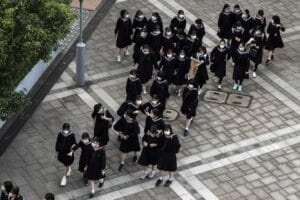No products in the cart.
The Cultural Significance of Uniforms in Japan: Conformity and Collective Identity
Introduction
Uniforms in Japan are an integral part of life in serving not just as practical attire but as symbols of a deeper cultural fabric woven around the concepts of conformity, collective identity, and societal expectations. From the sharp suits of salarymen to the rugged attire of construction workers and the iconic uniforms worn by primary school students, the ubiquity of uniforms across Japanese society speaks to a longstanding cultural inclination to fit in rather than stand out. This practice of wearing uniforms in different sectors and phases of life reflects a collective sense of order, discipline, and the importance of belonging to a group, which are core elements of Japanese culture.
Salaryman Uniforms: A Symbol of Dedication and Collective Effort
The term “salaryman” refers to the quintessential white-collar worker in Japan. This group, dressed in nearly identical dark suits with white shirts and ties, is synonymous with Japan’s corporate workforce. The uniforms in Japan of the salaryman is more than just professional attire—it represents a code of conduct, signaling the values of hard work, loyalty, and unity.
The uniformity among salarymen mirrors a cultural emphasis on collective effort over individual ambition. In Japan, standing out in a work setting is not typically encouraged. Instead, blending in with colleagues and appearing as part of a cohesive unit is valued. This reflects the larger societal belief that group harmony, or wa, should take precedence over individual expression. By dressing alike, salarymen symbolize their commitment to their companies, often seen as their second family. The uniform becomes a metaphor for loyalty and the willingness to prioritize the needs of the company over personal comfort or expression.
Salarymen are also known for their long working hours, which are culturally linked to dedication and commitment. The suit, often worn from early morning until late at night, embodies this unyielding work ethic. The uniforms in Japan reinforce the idea that the salaryman is part of something larger than himself, and in that sense, it becomes a symbol of national pride.

Construction Worker Uniforms: Functionality Meets Tradition
While the attire of Japan’s construction workers may differ from the suits of salarymen, it still adheres to the nation’s cultural values of discipline, order, and fitting into a collective. Japanese construction workers wear nikkapokka—baggy pants that allow for ease of movement, paired with helmets and other protective gear. The uniform is practical, designed for physical labor, but it also carries a cultural weight.
In Japanese society, manual labor is respected, and construction workers, despite the nature of their work, are seen as playing a vital role in society’s infrastructure. The uniform becomes a badge of honor, signaling that the wearer is part of the hard-working class that contributes to the country’s development. Much like the salaryman’s suit, the construction worker’s uniform represents a commitment to duty and responsibility.
Moreover, construction workers often work in tightly knit groups, much like corporate teams, where the concept of unity is critical. Wearing the same uniforms in Japan foster a sense of camaraderie and trust among workers. This is reflective of a larger Japanese cultural value: the importance of nakama, or comradeship, where the group takes precedence over the individual. Whether working on high-rise buildings or smaller local projects, construction workers adhere to a code of teamwork and mutual respect, all symbolized through their uniform.
Primary School Uniforms: Early Lessons in Discipline and Unity
Perhaps one of the most iconic images associated with Japanese culture is that of primary school children wearing their uniforms. From sailor-style outfits to blazers and ties, school uniforms are deeply ingrained in Japanese education, serving as a constant reminder of discipline, responsibility, and the importance of fitting into society from a young age.
In Japan, school uniforms are a way to create equality among students, reducing social and economic differences. By dressing alike, children learn early on that they are part of a larger community where everyone is expected to follow the same rules and standards. Uniforms in Japan foster a sense of belonging and help instill the values of order and discipline that are so important in Japanese society.
Furthermore, the practice of wearing uniforms also teaches children about the importance of appearance and how it reflects their respect for school and authority. Students are expected to keep their uniforms neat and tidy, signaling their readiness to learn and participate in the school community. As they grow older, the uniform also serves as a bridge between their school life and their future professional lives, where the cultural emphasis on conformity and fitting into a group continues.
The Deeper Cultural Implications of Uniformity
The prominence of uniforms in Japan, across different professions and stages of life, reflects the country’s deep-rooted cultural inclination toward conformity, group identity, and collective effort. In Japanese society, standing out is often seen as disruptive to the harmony of the group, whether that group is a classroom, a corporate team, or a construction crew. Uniforms, in this context, serve as a visual reminder of the importance of blending in and adhering to societal norms.
This is not to say that individuality has no place in Japan—indeed, there are many subcultures and communities that embrace more expressive forms of dress and lifestyle. However, in mainstream society, particularly in professional and academic settings, the pressure to conform is strong. This cultural trait has roots in Japan’s historical Confucian values, where harmony and social order were prioritized over individualism. In modern times, these values are still reflected in the widespread use of uniforms in Japan, which help maintain a sense of structure and collective identity.
At the same time, the practice of wearing uniforms can create tension for individuals who feel constrained by the expectation to conform. In recent years, there has been some pushback against the rigid use of uniforms in schools and workplaces, with debates over whether they stifle creativity or reinforce outdated norms. However, the cultural weight of uniforms in Japan remains significant, and they continue to be a defining aspect of life.
Conclusion: Uniforms as a Window into Japanese Culture
In Japan, uniforms serve as more than functional attire—they are a reflection of the nation’s deep-rooted cultural principles. Whether it’s the polished suits of office workers, the sturdy outfits of construction crews, or the tidy uniforms in Japan worn by schoolchildren, these garments symbolize Japan’s emphasis on unity, discipline, and respect for the collective. They highlight a society that prioritizes harmony and social cohesion, even as it navigates the balance between its traditional roots and the pressures of modern life. In a culture where individuality can sometimes be viewed as disruptive, uniforms play a crucial role in preserving the order and unity that are central to Japanese values.










